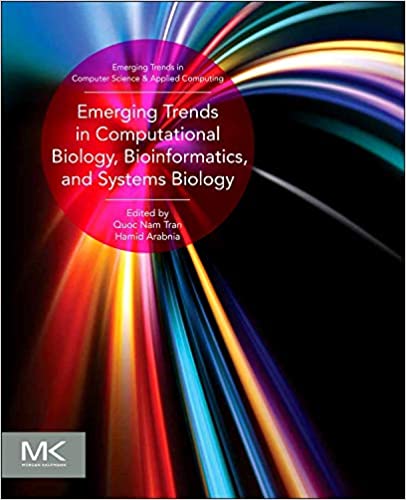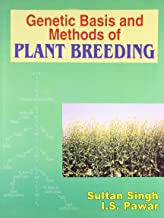Emerging Trends in Computational Biology, Bioinformatics, and Systems Biology
Original price was: ₹10,036.00.₹8,028.80Current price is: ₹8,028.80.
ISBN: 9780128025086
Author/Editor: Arabnia
Publisher: Elsevier
Year: 2015
1 in stock (can be backordered)
Description
Emerging Trends in Computational Biology, Bioinformatics, and Systems Biology discusses the latest developments in all aspects of computational biology, bioinformatics, and systems biology and the application of data-analytics and algorithms, mathematical modeling, and simu- lation techniques.
?Discusses the development and application of data-analytical and theoretical methods, mathematical modeling, and computational simulation techniques to the study of biological and behavioral systems, including applications in cancer research, computational intelligence and drug design, high-performance computing, and biology, as well as cloud and grid computing for the storage and access of big data sets.
?Presents a systematic approach for storing, retrieving, organizing, and analyzing biological data using software tools with applications to general principles of DNA/RNA structure, bioinformatics and applications, genomes, protein structure, and modeling and classification, as well as microarray analysis.
?Provides a systems biology perspective, including general guidelines and techniques for obtaining, integrating, and analyzing complex data sets from multiple experimental sources using computational tools and software. Topics covered include phenomics, genomics, epigenomics/epigenetics, metabolomics, cell cycle and checkpoint control, and systems biology and vaccination research.
?Explains how to effectively harness the power of Big Data tools when data sets are so large and complex that it is difficult to process them using conventional database management systems or traditional data processing applications.
Additional information
| Weight | 1.38 kg |
|---|
Product Properties
| Year of Publication | 2015 |
|---|---|
| Table of Contents | Preface Acknowledgments Introduction Chapter 1: Supervised Learning with the Artificial Neural Networks Algorithm for Modeling Immune Cell Differentiation Abstract Acknowledgments 1 Introduction 2 Related work 3 Modeling immune cell differentiation 4 Discussion 5 Conclusion Chapter 2: Accelerating Techniques for Particle Filter Implementations on FPGA Abstract 1 Introduction 2 PF and SLAM algorithms 3 Computational bottleneck identification and hardware/software partitioning 4 PF acceleration techniques 5 Hardware implementation 6 Hardware/software Architecture 7 Results and discussion 8 Conclusions Chapter 3: Biological Study on Pulsatile Flow of Herschel-Bulkley Fluid in Tapered Blood Vessels Abstract 1 Introduction 2 Formulation of the problem 3 Solution 4 Discussion 5 Conclusion Chapter 4: Hierarchical k-Means: A Hybrid Clustering Algorithm and Its Application to Study Gene Expression in Lung Adenocarcinoma Abstract 1 Introduction 2 Methods 3 Data set 4 Results and Discussion 5 Conclusions Supplementary materials Chapter 5: Molecular Classification of N-Aryloxazolidinone-5-carboxamides as Human Immunodeficiency Virus Protease Inhibitors Abstract Acknowledgments 1 Introduction 2 Computational method 3 Classification algorithm 4 Information entropy 5 The EC of entropy production 6 Learning procedure 7 Calculation results and discussion 8 Conclusions Chapter 6: Review of Recent Protein-Protein Interaction Techniques Abstract 1 Introduction 2 Technical challenges and open issues 3 Performance measures 4 Computational approaches 5 Conclusion Chapter 7: Genetic Regulatory Networks: Focus on Attractors of Their Dynamics Abstract Acknowledgments 1 Introduction 2 Immunetworks 3 The iron control network 4 Morphogenetic networks 5 Biliary atresia control network 6 Conclusion and perspectives Mathematical Annex Chapter 8: Biomechanical Evaluation for Bone Allograft in Treating the Femoral Head Necrosis: Thorough Debridement or not? Abstract 1 Introduction 2 Materials and methods 3 Results 4 Discussion 5 Conclusion 6 Disclaimer Chapter 9: Diels-Alderase Catalyzing the Cyclization Step in the Biosynthesis of Spinosyn A: Reality or Fantasy? Abstract Acknowledgments Graphical Abstract 1 Introduction 2 Computational methods 3 Results and discussion 4 Conclusions Supplementary Material: Diels-Alderase Catalyzing the Cyclization Step in the Biosynthesis of Spinosyn A: Reality or Fantasy? 1 Conformational analysis of macrocyclic lactone (4) 2 Modelling of a theozyme for the conversion of macrocyclic lactone (4) into tricyclic compound (5) 3 ELF bonding analysis of the conversion of macrocyclic lactone (4) into the tricyclic compound (5) Chapter 10: CLAST: Clustering Biological Sequences Abstract Acknowledgments 1 Introduction 2 Methods 3 Evaluation and discussion 4 Conclusions Chapter 11: Computational Platform for Integration and Analysis of MicroRNA Annotation Abstract 1 Introduction 2 Material 3 MIRIA Database 4 MiRNA CFSim 5 Web Framework 6 Results 7 Conclusions Chapter 12: Feature Selection and Analysis of Gene Expression Data Using Low-Dimensional Linear Programming Abstract Acknowledgments 1 Introduction 2 LP formulation of separability 3 Offline approach 4 Incremental approach 5 Gene selection 6 A new methodology for gene selection 7 Results and discussion 8 Conclusions Chapter 13: The Big ORF Theory: Algorithmic, Computational, and Approximation Approaches to Open Reading Frames in Short- and Medium-Length dsDNA Sequences Abstract Acknowledgments 1 Introduction 2 Molecular genetic and bioinformatic considerations 3 Algorithmic and programming considerations 4 Analytical and random sampling solutions to L > 25 sequences: Triplet-based approximations 5 Alternative genetic codes 6 Implications for the evolution of ORF size Chapter 14: Intentionally Linked Entities: A Detailed Look at a Database System for Health Care Informatics Abstract Acknowledgments 1 Introduction 2 Introducing ILE for Health Care Applications 3 ILE and epidemiological data modeling 4 Other nonrelational approaches to keeping medical records 5 Inside the ILE database system 6 An example of the Importance of an EHR implemented in ILE 7 Conclusions Chapter 15: Region Growing in Nonpictorial Data for Organ-Specific Toxicity Prediction Abstract 1 Introduction 2 Related works 3 Basic foundation 4 Methodology 5 Empirical results 6 Conclusions and future research Chapter 16: Contribution of Noise Reduction Algorithms: Perception Versus Localization Simulation in the Case of Binaural Cochlear Implant (BCI) Coding Abstract Acknowledgments 1 Introduction 2 Materials and Methods 3 Results 4 Discussion 5 Conclusions Chapter 17: Lowering the Fall Rate of the Elderly from Wheelchairs Abstract Acknowledgments 1 Introduction 2 Current solutions 3 A systems solution 4 The sparrow design 5 Assessment algorithm 6 Assessment decision algorithm 7 The future 8 Conclusion Chapter 18: Occipital and Left Temporal EEG Correlates of Phenomenal Consciousness Abstract Acknowledgments 1 Introduction 2 Participants 3 Apparatus and stimuli 4 Procedure 5 EEG recording 6 Experiment I 7 Experiment II 8 The grand average occipital and temporal electrical activity correlated with a contrast in access 9 Behavioral data 10 The grand average occipital and temporal electrical activity correlated with a contrast in phenomenology 11 The grand average occipital and temporal electrical activity co-occurring with unconsciousness Chapter 19: Chaotic Dynamical States in the Izhikevich Neuron Model Abstract 1 Introduction 2 Fundamental description 3 Chaotic properties of Izhikevich neuron model 4 Response efficiency in chaotic resonance 5 Conclusions Chapter 20: Analogy, Mind, and Life Abstract Acknowledgements 1 Introduction 2 The artificial mind and cognitive science 3 Consciousness 4 The classic watchmaker analogy 5 The classic watchmaker analogy is fragile, remote and reductive 6 The analogy between life and information seems to suggest some type of reductionism 7 Conclusion Chapter 21: Copy Number Networks to Guide Combinatorial Therapy of Cancer and Proliferative Disorders Abstract Acknowledgments 1 Introduction 2 A diminishing drug pipeline 3 Using genome data to replenish the pipeline by drug repositioning 4 The small-world properties of networks expedite combination therapies 5 Molecular networks can be used to guide drug combinations 6 Copy number alterations as a disease driver 7 Using correlated copy number alterations to construct survival networks 8 A pan-cancer CNA interaction network 9 Mapping genetic survival networks using correlated CNAs in radiation hybrid cells 10 A survival network for GBM at single-gene resolution 11 Using CNA networks to guide combination therapies 12 Targeting multiple drugs to single-disease genes in cancer 13 Targeting multiple drugs to a single-disease gene in autoimmunity 14 Targeting multiple genes in a single pathway for cancer 15 Targeting genes in parallel pathways converging on atherosclerosis 16 Using CNA networks to synergize drug combinations and minimize side effects 17 Disclaimer Chapter 22: DNA Double-Strand Break?ased Nonmonotonic Logic Abstract 1 Introduction 2 DNA DSBs 3 Logical model for system biology 4 Completing the signaling pathways by default abduction 5 Logic representation of a signaling pathway with the goal of reducing computational complexity 6 Algorithm and implementation 7 Results 8 Conclusions Chapter 23: An Updated Covariance Model for Rapid Annotation of Noncoding RNA Abstract 1 Introduction 2 Method 3 Test results 4 Conclusions Chapter 24: SMIR: A Web Server to Predict Residues Involved in the Protein Folding Core Abstract Acknowledgments 1 Introduction 2 Methods 3 Results 4 Conclusion Chapter 25: Predicting Extinction of Biological Systems with Competition Abstract Acknowledgments 1 Introduction 2 A Model of Competing Species 3 Density function of extinction time 4 Estimation of parameters 5 Numerical results 6 Summary Chapter 26: Methodologies for the Diagnosis of the Main Behavioral Syndromes for Parkinson? Disease with Bayesian Belief Networks Abstract 1 Introduction 2 Diagnosis of FoG 3 Diagnosis of handwriting and speech 4 Toward a global methodology for PD 5 Conclusions and future work Chapter 27: Practical Considerations in Virtual Screening and Molecular Docking Abstract 1 Introduction 2 Receptor structure preparation 3 Accurately predicting the pose of solved crystal structures and differentiating decoys from actives 4 Side-chain flexibility and ensemble docking 5 Consensus docking 6 MM-GBSA 7 Incorporating pharmacophoric constraints within the virtual screen 8 Conclusion Chapter 28: Knowledge Discovery in Proteomic Mass Spectrometry Data Abstract 1 Introduction 2 Technical background 3 Computational workflow 4 Analysis tool 5 Conclusion Chapter 29: A Comparative Analysis of Read Mapping and Indel Calling Pipelines for Next-Generation Sequencing Data Abstract 1 Introduction 2 Mapping and calling software 3 Methods 4 Real data 5 Results and discussion 6 Conclusions Chapter 30: Two-Stage Evolutionary Quantification of In Vivo MRS Metabolites Abstract Acknowledgments 1 Introduction 2 Proposed methodology 3 Experiment 4 Conclusions Chapter 31: Keratoconus Disease and Three-Dimensional Simulation of the Cornea throughout the Process of Cross-Linking Treatment Abstract Acknowledgments 1 Introduction 2 Methodology 3 Conclusions and Recommendations Chapter 32: Emerging Business Intelligence Framework for a Clinical Laboratory Through Big Data Analytics Abstract 1 Introduction 2 Motivation 3 Material and methods 4 Use-cases 5 Case Study 1: Clinical laboratory test usage patterns visualization 6 Data source and methodology 7 Results and discussion 8 Limitations 9 Case Study 2: Provincial laboratory clinical test volume estimation 10 Data source and methodology 11 Results and discussion 12 Limitations 13 Conclusion and future work Chapter 33: A Codon Frequency Obfuscation Heuristic for Raw Genomic Data Privacy Abstract 1 Introduction 2 Background 3 Related work 4 Methodology 5 Experiment and results 6 Conclusion Index |
| Author | Arabnia |
| ISBN/ISSN | 9780128025086 |
| Binding | Paperback |
| Edition | 1 |
| Publisher | Elsevier |
You must be logged in to post a review.






Reviews
There are no reviews yet.